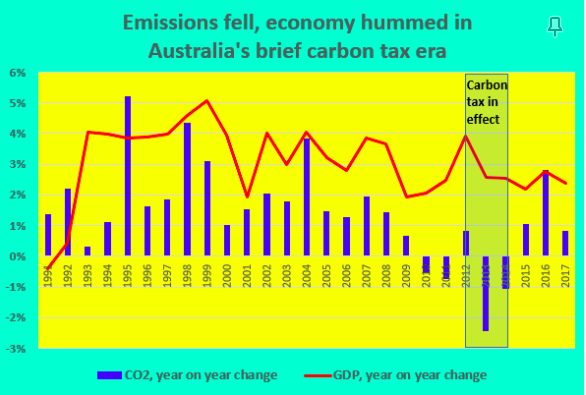Implementation of a Carbon Tax: Learning from the Mistake of Others
Carbon dioxide (CO2) is a significant heat-trapping, greenhouse gas, which is released through human activities such as burning fossil fuels and deforestation, and natural processes such as respiration and volcanic eruptions.[1] Increases in atmospheric CO2 are responsible for about two-thirds of the total energy imbalance that is causing Earth's temperature to rise.[2] This imbalance can create devastating impacts such as extreme weather events like flooding, deadly storms; the spread of disease, sea level rise, and other natural disasters. These events contribute to other issues, like an increase in food insecurity, due to decrease in productivity from inconsistent crop yields and increasing competition for fresh water.[3]
Often, the individuals responsible for CO2 emissions do not have to pay the full cost that comes with changing the Earth’s climate. Currently, the carbon offset market in the U.S. is predominantly privately owned. Carbon offsets are bought and sold through private markets for companies/ individuals to present themselves as more eco-friendly. One example of a carbon offset tool used by other countries is the implementation of a carbon tax. A carbon tax is a fee imposed on the burning of carbon-based fuels (coal, oil, gas).[4] For many, a carbon tax is the core policy for reducing and eventually eliminating the use of fossil fuels whose combustion is destabilizing and destroying our climate. Utilizing existing tax collection mechanisms, a carbon tax is paid “upstream,” i.e., at the point where fuels are extracted from the Earth and put into the stream of commerce or imported into the U.S; making emitters held accountable for their output of CO2 by having to pay the tax. By raising the price of fossil fuels, it can guarantee that consumers will make purchasing and investment decisions taking into account the full costs of their actions.[5]
As of 2018, more than 25 national or subnational carbon tax systems had been implemented or were scheduled to be implemented around the world.[6] One country that was once part of that system is Australia, who on July 1, 2012 instituted a carbon tax, but repealed it two years later, on July 17, 2014.[7] Australia’s carbon tax was introduced through their Clean Energy Act 2011 and was intended to control emissions in the country, as well as support the growth of the economy through the development of clean energy technologies. The Bill named 294 firms that were liable to pay the AUD$23/tonne ($22.96/tonne) carbon tax, with electricity generators, steel makers and mining companies among the biggest emitters.[8] Consequently, the tax increased household electricity prices by 15 percent — the highest quarterly increase in the country’s history.[9] These rising electricity costs meant higher prices for almost all goods and services and fewer future job opportunities for businesses trying to stay afloat. Australia attempted to score some support from the general public by giving more than half of the revenue raised by the carbon tax to lower and middle income households, however the lack of political credibility made this effort insufficient.[10]
Julia Guillard, 2010 Labor Party prime minister
Originally in 2010, the Labor Party prime minister, Julia Guillard, made promises that no carbon taxes would be created while she was in position.[11] Due to pressure to form a minority government, she did wind up making a deal with the Green Party and agreed to legislate a carbon price: a tax by any other name. However, the prime minister’s earlier pledge to not tax carbon emissions and her “perceived lack of conviction in the policy itself” damaged the tax’s credibility and her own viability. This led longtime Labor Party supporters to vote for the opposing party in the next election which led to the repeal of the carbon tax in 2014.
While taking caution from how the carbon tax left the Australian government in disarray, there is some appeal in following in Australia’s footsteps. Even though there was a political failure with the carbon tax, CO2 emissions from burning fossil fuels in Australia fell 2.4 percent in 2013 and 1.1 percent in 2014, with total emissions in 2014 being 14 million metric tons less than in 2012.[12] In the United States, at both the state and federal levels, interest in an economy-wide carbon tax has been gradually growing. Carbon tax proposals have been introduced in the United States Congress for several years without success, but supporters hope that the need for new revenues to pay for tax reform or infrastructure will make it more politically appealing.[13] Nonetheless, recycling of revenue is just one lesson the U.S. can learn from Australia’s carbon tax failures.
Carbon taxes can help reflect the true long-term costs of different types of carbon-based energy sources, such as coal, natural gas, and oil. Looking at Australia’s attempt demonstrates that a carbon price design that creates equality for lower income citizens is not sufficient and that politics and political communication are of crucial importance.[14] Since America’s carbon offset market is open for improvement, a carbon tax may be a viable option in the future. While there is no one specific way to create a successful carbon tax, the U.S. can start the process by trying to avoid the problems encountered by other countries in the past.
Author: Emma Cross, Legal Intern at Amata Green. 2020
[1] NASA, Carbon Dioxide, https://climate.nasa.gov/vital-signs/carbon-dioxide/ (last updated May 2020).
[2] Rebecca Lindsey, Climate Change: Atmospheric Carbon Dioxide, NOAA Climate, (Feb. 20, 2020), https://www.climate.gov/news-features/understanding-climate/climate-change-atmospheric-carbon-dioxide
[3] Climate Policy Watcher, Impacts of Greenhouse Gas Emissions on Food Security (last updated Mar. 21, 2020), https://www.climate-policy-watcher.org/agriculture-organization/impacts-of-greenhouse-gas-emissions-on-food-security.html
[4] Carbon Tax Center, What’s a Carbon Tax?, https://www.carbontax.org/whats-a-carbon-tax/ (last visited July 2, 2020).
[5] Taylor McNeil, Why a Carbon Tax Makes Sense, Tufts U. (Feb. 21, 2019), https://now.tufts.edu/articles/why-carbon-tax-makes-sense.
[6] Gilbert Metcalf, Carbon Taxes: What Can We Learn From International Experience?, ECONOFACT (May 3, 2019) https://econofact.org/carbon-taxes-what-can-we-learn-from-international-experience.
[7] Claudia Irigoyen, The Carbon Tax in Australia, Centre for Public Impact (May 5, 2017), https://www.centreforpublicimpact.org/case-study/carbon-tax-australia/.
[8] James Grubel, Australia cuts number of firms to pay carbon tax, Reuters (June 15, 2012), https://www.reuters.com/article/us-australia-carbon-list/australia-cuts-number-of-firms-to-pay-carbon-tax-idUSBRE85E09W20120615
[9] Daniel Simmons, Lessons Congress Can Learn from Australia’s Carbon Tax Debacle | Commentary, Roll Call (July 25, 2015, 1:30PM), https://www.rollcall.com/2014/07/25/lessons-congress-can-learn-from-australias-carbon-tax-debacle-commentary/.
[10] Timothy Hurst, What U.S. Lawmakers Can Learn from Australia's Carbon Tax, Reuters (July 18, 2011, 2:01PM),
https://www.reuters.com/article/idUS195397650120110718.
[11] Carbon Tax Center, Where Carbon Is Taxed?, https://www.carbontax.org/where-carbon-is-taxed/#Australia (last updated 2020).
[12] Claudia Irigoyen, The Carbon Tax in Australia, Centre for Public Impact (May 5, 2017), https://www.centreforpublicimpact.org/case-study/carbon-tax-australia/.
[13] Center for Climate and Energy Solutions, Carbon Tax Basics, https://www.c2es.org/content/carbon-tax-basics/ (last visited July 2, 2020).
[14] Franziska Funke and Linus Mattauch, Why is carbon pricing in some countries more successful than in others?, Our World in Data (August 10, 2018), https://ourworldindata.org/carbon-pricing-popular.




